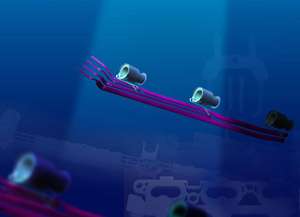Electrical components in a single molding operation

Siemens researchers have developed a composite made of plastic and metal that can be processed like a plastic, but has the electrical and electromagnetic properties of metal. The new plastic-metal hybrid is designed to simplify the production of electrical components such as transmission and engine control units. When heated, the material can be processed with conventional injection molding machines as used in the plastics industry. Numerous experiments have shown that conductor paths as well as contacts for plug-in connections or cables can be injection-molded with the material in one operation. Time-consuming soldering processes are no longer necessary and the production process is speeded up.
Electronic engine components are usually enclosed in plastic housings which are formed from molten plastic in injection molding machines. In subsequent production steps automatic machines apply thin metal layers on the inside of the housing to act as conductors, and then solder resistors, electrical coils and plug-in connections permanently in position. Finally cables are screwed on. In other words a large number of production steps are necessary to make a finished control unit the size of a cigar box, for example for fuel injection valves. Developers at the Functional Polymers department of Siemens Corporate Technologies in Erlangen hope to speed up these processes with the new plastic-metal hybrid. The material consists of about 10 to 20 percent plastic, and about 50 percent copper. The rest is made up of a solder that melts at relatively low temperatures. In combination the various ingredients give the special plastic its unusual properties. Because of the low melting point of the solder the material remains fluid during processing despite the large proportion of filler material. It can therefore be processed with standard injection molding machines and can be injected into a mold through fine nozzles. Thanks to the high copper content the conductivity of the material is significantly higher than conventional conductive compounds. The new material also retains its conductivity at high temperatures since the copper in the plastic forms a closely branched network. The plastic itself provides good adhesion in the plastic housing. “The chief advantage of this material is that the conductor tracks and contacts can be formed during the actual injection molding process and not in subsequent steps,” said Dr. Robert Greiner, the man who developed the new material. His idea is as follows: Once the plastic housing has cooled, the injection molding machine forces conductor tracks and all necessary contact points into the housing through fine nozzles. The coils and connectors can then be inserted in a subsequent step. “The compound only needs to be heated up briefly a second time to soften it a little; connectors, cables and so forth can then be pressed into the soft material,” explained Greiner. Time-consuming soldering is no longer necessary. Also the surface tension of the plastic-metal is significantly lower than that of ordinary solder, and the material retains its shape. Solder, on the other hand, bulges out in a semispherical shape, which makes soldering difficult.
The production of conductor paths using stamped inserts is also considerably simplified by the new plastic from Erlangen. These stamped inserts are used, for example, in vehicles particularly in applications where several conductor paths run parallel in electronic components – for example from one injection valve to the next along the cylinders. In order to produce the parallel conductors, the present method is to stamp out a grid-like insert from sheet steel with the conductors running side by side and bend it into shape. This insert is then partially enclosed in plastic. The cross connections are then cut between the parallel conductors, otherwise current cannot flow. At the end the component is covered in plastic. Here again a large number of process steps are necessary. In contrast, the new material can be injected directly into the plastic cover, and contacts provided for the control coils for the engine valves at the same time. “We can inject thick or thin conductors depending on how heavy the current flows in the engine are,” said Greiner. “The process is outstandingly flexible.”
In December last year the polymer experts from Erlangen applied for a patent for their material. First applications such as injected antennas for mobile data memories and conductors for engine fuel injection systems to replace stamped inserts could be used in the near future. “The material can already be used in series production,” Greiner stated.
Source: Siemens
















